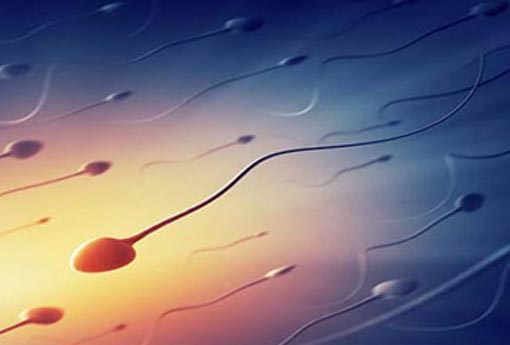Basic Information
Chinese name: semen
Source: Male Sexual Organs
Semen overview
Semen consists of sperm and seminal plasma, of which sperm accounts for 10% and the rest is seminal plasma. In addition to water, fructose, protein and fat, it also contains a variety of enzymes and inorganic salts. Semen contains zinc.
Semen is the combination of sperm and secretions produced by the testes and secretions of the reproductive duct glands (epididymis, prostate, seminal vesicles, urethral accessory glands, etc.). The prostatic fluid, seminal vesicle fluid, and a small amount of fluid secreted by the bulbourethral glands are collectively called seminal plasma. Seminal plasma is an essential medium for transporting sperm and provides energy and nutrients for sperm. Simply put, semen consists of two parts, one part sperm and one part seminal plasma. Therefore, when many men ask "how is my sperm", it is obvious that they do not understand the composition of semen, because sperm cannot be seen by the naked eye. The volume of each ejaculate is about 2-6 ml, which seems to be a little bit.
Semen sperm are produced by the testes. Seminal plasma is produced by the prostate, seminal vesicles and bulbourethral glands. Seminal plasma contains fructose and protein, which are nutrients for sperm. In addition, seminal plasma also contains prostaglandins and some enzymes.
Semen is alkaline, and the interior of the female genitalia is acidic. As a result, semen enters the female and is neutralized. Fertilized eggs are formed. A normal male with fertility has a maximum of 2-6 ml of ejaculate, with an average of 3.5 ml. There is a negative correlation between the amount of ejaculate and the frequency of ejaculation. If the amount of ejaculation is still less than 2 ml for 5-7 days of abstinence, it is regarded as a decrease in semen; if there is no ejaculation, it is called aspermia. Seminal plasma is the mediator of sperm motility and neutralizes the acidic secretions of the vagina so as not to affect sperm motility. Decreased semen volume (insufficient seminal plasma) is not conducive to the passage of sperm into the uterus and fallopian tubes through the vagina, affecting fertilization. If the amount of ejaculate exceeds 8 ml at a time, the sperm will be diluted, which is not conducive to fertility. this can be due to the hypersecretion of gonadotropin in the anterior pituitary, which increases the level of androgen and can also be seen in those who have abstinence for too long.
Semen contains an antibacterial substance comparable to penicillin - semen cytoplasmin. Experts pointed out that semen cytoplasmin is a protein with a unique function. once this substance enters the cell, it can prevent the synthesis of ribonucleic acid, thereby killing bacteria. It has been observed from laboratory culture that semen cytoplasmin can kill Staphylococcus, Streptococcus and other pathogenic bacteria.
Some men, propaganda by some feudal superstitions, pay special attention to their semen. Because of the ignorance of the ancients, there is a saying that "one drop of essence, ten drops of blood". This is completely unscientific. Modern scientific research has proved that semen is not the essence of the so-called male at all. Its composition is similar to that of excreted sweat.
component
If you want contraception, here's another reason to be suspicious of cyclic birth control: A new study confirms that semen semen, in addition to its longstanding role as a sperm-carrying vehicle, contains a A substance that triggers ovulation and other hormonal responses that support pregnancy in female mammals. The discovery could lead to new fertility treatments for humans.
Like most female animals, women are spontaneous ovulators, which means that their ovulation follows certain basic patterns that have nothing to do with sexual activity. However, in several animals such as camels and rabbits, ovulation occurs only in response to sexual activity. These animals are called "ovulation inducers". For decades, the scientific creed has been fixed on ovulation induction, that physical stimulation in males triggers a hormonal response in females that leads to the maturation and release of eggs. However, in 1985, a Chinese research team put forward a qualitative coagulation against this belief, arguing that semen itself may have an ovulation-inducing factor (OIF). According to Gregg Adams, a veterinarian and reproductive biologist at the University of Saskatchewan in Saskatoon, Canada, this hypothesis contradicts common knowledge: "People just ignore it, including me. ."
Decades later, when Adams and his colleagues finally tested the hypothesis, they were taken aback by the results. In 2005, Adams' team injected sperm from male llamas -- llamas are closely related to camels -- into the hind legs of female llamas to see if they would ovulate without genital stimulation. To their surprise, he said, the serum-injected female llamas had "a very potent ovulatory effector in their bloodstream."
This triggered a 7-year search for OIF in semen. Now, in a paper published in the Proceedings of the National Academy of Sciences (August 20, 2012), Adams and his colleagues say they have found the OIF. The researchers took semen samples from male llamas and bulls to see if OIF could be found in the semen of both ovulation-induced and spontaneous breeds. They spin the semen quickly in a centrifuge several times to separate the sperm from the semen. Sperm only makes up about 5 percent of semen, Adams said. The team then used heat, various protein-digesting enzymes and filters of different sizes to screen for molecules that worked. After each treatment, Adams says, they go through "a very thorough process of elimination." Change the site where the serum is injected into the hindquarters of female llamas to see if the molecule is still active and effective in inducing ovulation, or has destroyed. To Adams' surprise, the mysterious substance turned out to be a protein that is essential for the development and survival of sensory neurons: nerve growth factor, or NGF. "We were looking for an unknown protein," Adams said. But, through studies of many species of organisms, it turned out that OIF/NGF was in fact the same molecule. "I don't know whether to be happy or sad about this result," he said with a smile.
Adams said NGF was discovered in bull semen in the early 1980s, but "it was just one of those dangling facts, and no one knew what it was doing." Now, he says, "we can connect the dots. Get up." He and his colleagues found that this same molecule was abundant in every species they studied, including human semen. In other experiments, they established that the molecule promotes reproduction in various breeds: for example, serum from bulls, male rabbits, and stallions induces ovulation in female llamas, and serum from male llamas, Induction of ovulation in pre-pubertal mice. Although, NGF does not appear to induce ovulation in other spontaneous ovulators they have studied, such as cows, but has additional effectors that promote fertility in cows. Here, NGF alters the developmental rhythm of the follicles that incubate the egg and promotes the development and function of the corpus luteum, a temporary endocrine structure critical to maintaining pregnancy.
As the first evidence, NGF, or OIF, from semen, which spreads throughout the female's body and acts as a hormone, "is really new to us," Adams said. In the next phase, the team Plans to study how NGF affects human fertility. "We're really interested in understanding the relationship between OIF and infertility," he said. "Does the higher the concentration of OIF in men's semen, the more fertile they are?" For couples who are struggling to conceive, he said , perhaps a treatment for OIF could be developed.
Sergio Ojeda, a neuroscientist at Oregon Health and Tech University in Portland, who studies the role of neurotrophic factors -- proteins that include NGF -- in the female reproductive system, said, The research is "very exciting". Scientists wondered if this type of NGF, once thought to act only on nerves in the sensory areas of the nervous system, also plays an important role in reproduction. The new study, he says, shows that NGF in male semen actually travels through the female's bloodstream to the brain, causing the female's hypothalamus and pituitary gland to release hormones needed for pregnancy. Although the exact mechanism by which NGF acts on the pituitary gland and hypothalamus still needs to be studied in detail, the study itself appears to be reliable, Ojeda said. The study, he said, was well done and "scientifically exciting. They decided to find this molecule, it was not a preconceived idea at all. They found this molecule, and the study was very well done. ."
Standard detection
normal standard
Normal semen is gray-white, and after self-liquefaction, it is translucent milky white, and those who have not ejaculated for a long time may be slightly pale yellow. Those whose semen is bright red, light red, dark red or soy sauce color and contain a large number of red blood cells are called hemospermia, which may be caused by non-specific inflammation of the prostate and sperm, germline tuberculosis, tumors or stones. Yellow or brown purulent semen is seen in prostatitis. and seminal vesiculitis. For the average healthy man, without unclean sex, or venereal disease, the color and shape of the semen doesn't matter at all. Male diseases are not diagnosed by looking at semen on the surface. The sperm in the semen combines with the woman's egg to reproduce offspring, which is the sole function of semen. Therefore, it is absolutely impossible for a woman to become pregnant if semen is swallowed. For single men, if they don't even have a partner, there is no need to worry about their semen problems. It is completely self-inflicted. If the woman is still not pregnant after a year of marriage, then it is time to see a doctor to find out the cause of infertility.
If the semen is taken for examination, it should not ejaculate within 5 days before the examination. Semen is generally collected, which can be obtained by masturbation, or through sexual intercourse with a condom. After semen is collected, it should be placed in a dry, clean bottle and sent for inspection immediately.
According to the normal semen standard stipulated by the World Health Organization, whether the semen is normal can be analyzed from the following aspects:
⑴Semen volume: normal ≥2ml. When it is more than 7ml, it is too much, not only the sperm density is reduced, but also it is easy to flow out of the vagina, so that the total number of sperm is reduced, which is common in seminal vesiculitis; less than 2ml is too little semen, but usually less than 1ml is too little. At this time, the contact area between the semen and the female reproductive tract is small, or the stickiness is not conducive to the entry of sperm into the woman's cervix, resulting in infertility.
⑵ Color: normal is off-white or slightly yellow. Milky white or yellow-green color indicates inflammation of the genital tract or accessory gonads; pink, red, red blood cells seen under the microscope are bloody semen, common in inflammation of accessory gonads and posterior urethra, and occasionally seen in tuberculosis or tumors.
(3) pH: The normal pH of semen is 7.2 to 7.8. Less than 7.2 is seen in ejaculatory duct obstruction or urine contamination; greater than 7.8 is seen in seminal vesicle inflammation or old specimens.
⑷ Liquefaction time: After the normal semen is ejected, it becomes jelly under the action of seminal vesicle coagulase, and becomes liquid under the action of prostate liquefaction enzyme in 15 to 30 minutes, which is semen liquefaction. It is abnormal for the semen to not liquefy 30 minutes after ejaculation.
⑸ Viscosity: Contact the glass rod with the liquefied semen and gently lift it to form semen silk, which is normally less than 2 cm in length.
⑹Sperm count: generally expressed as the number of sperm per milliliter of semen. Normal count ≥ 20 × 10? 6/ml. Below this value, there are too few sperm, which can be seen in spermatogenesis dysfunction caused by various reasons, which can lead to subfertility or infertility due to the reduced chance of sperm entering the uterine cavity and fallopian tubes. If the sperm count is greater than 250×10?6/ml, it is too many sperm, and its motility can also be affected, which can also lead to infertility.
⑺Sperm morphology: normal sperm ≥ 50%, otherwise it may cause infertility.
⑻ Motility: ≥50% of sperms move forward rapidly in a straight line.
⑼ Survival rate: usually refers to the inspection within 1 hour after ejaculation, and the viable sperm is more than 50%. Common causes of reduced sperm motility and viability include paragonadal inflammation, varicocele, sluggish ciliary syndrome caused by chronic respiratory infection, presence of antisperm antibodies in semen, or improper storage of specimens.
⑽ Leukocytes: Leukocytes in normal semen <1×10?6/ml. Leukocytosis indicates infection of the genital tract or accessory gonads.
semen test
Semen is a type of bodily fluid. Therefore, many STDs can be transmitted to each other through semen. The semen of AIDS patients contains the AIDS virus, so it can be transmitted to each other through sexual intercourse. Anal sex is a risky sexual activity because the tissues near the anus are more vulnerable, and if there is a ruptured wound, the semen with HIV can pass through the wound to the partner being anal sexed. This is why gay men are more likely to get AIDS. Heterosexual sex can also transmit STDs as long as there is an exchange of bodily fluids.
"The amount of semen that a man can excrete in his life is about four buckets (about 80 liters), and when he uses up the last drop of semen, a bead with the word 'finished' appears on it." — - a joke
In order to identify male fertility, doctors often ask the man to do a semen examination. The normal color of semen is gray or milky white. If the abstinence time is long, it can be light yellow, and if it appears bright red. Dark red, it indicates that the patient has inflammation or reproductive tract damage. The amount of ejaculation per ejaculation is 2-6 milliliters
liters, often affected by the number and frequency of ejaculation. Fresh semen is thick and jelly-like. It should be liquefied into a thin liquid within 1 hour. Insert a small glass rod into the semen and lift it up. Semen is weakly alkaline, with a pH of 7.2 to 7.8. The normal sperm count should exceed 20 million/ml. Active sperm >=50% within 1 hour after ejaculation. The World Health Organization recommends that sperm motility be divided into four grades: grade 0: inactive; grade 1: sperm swinging in place; grade 2: moderate forward movement; grade 3: active forward movement and fast linear movement. Normal sperm motility is 2~3 grade sperm>=40%~50%. Sperm morphology: abnormal sperm is less than 50%. Analysis of male fertility cannot be concluded from only one index of semen, and comprehensive ability analysis should be carried out in terms of sperm count, motility, activity rate, liquefaction time, and deformity rate.
Semen diagnosis
(1) Semen volume: the normal volume should be more than or equal to 2ml (ml). If it is more than 7ml, it is too much. At this time, not only the sperm density will become lower, but it will also easily flow out of the female vagina, resulting in a decrease in the total number of sperm, which is common in patients with seminal vesiculitis. If the total amount is less than 2ml, the amount of semen is low, and less than 1ml is too small, which may easily lead to infertility.
(2) Color: The normal color is off-white or slightly yellow. If semen appears milky white or yellow-green, it indicates inflammation in the male reproductive tract or accessory gonads. If pink, red, or red blood cells can be seen under the microscope, it is bloody semen. It is often seen in patients with paragonads, posterior urethra inflammation, and occasionally in patients with tuberculosis or tumors.
(3) Liquefaction time: After the normal semen is ejected, it will become jelly under the action of seminal vesicle coagulase, and after 15-30 minutes, it will become liquid under the action of prostate liquefaction enzyme, which is called semen liquefaction. If the semen does not liquefy after 30 minutes of ejaculation, it is abnormal.
(4) Viscosity: Contact the liquefied semen with a glass rod and gently lift it to form semen silk. If the semen is normal, the semen thread length should be less than 2 cm.
quality improvement
According to the theory of traditional Chinese medicine, the kidney and essence should be consumed in food supplements, such as: yam, eel, ginkgo, sea cucumber, frozen tofu, tofu skin, peanuts, walnuts, sesame, etc., to enhance the body's immunity. spermatogenesis ability. This coincides with the nutritional science of Western medicine. Western medicine believes that sufficient protein and vitamins can promote the production of sperm. Vitamin A, vitamin B, and vitamin E can increase reproductive function. In addition, some trace elements such as zinc, manganese, Deficiencies of elements such as selenium can also affect male fertility.
In addition, eating more green vegetables can help improve the quality of sperm, because green vegetables contain vitamin C, vitamin E, zinc, selenium and other ingredients that are conducive to sperm growth. Nuts and fish are rich in omega 3 fatty acids and should also be eaten more, which are conducive to the growth of sperm cells.
In particular, pay attention to zinc supplementation. Animal-based foods generally contain more zinc than plant-based foods. Foods rich in zinc are: lean meat, liver, eggs, dairy products, cocoa, lotus seeds, peanuts, sesame, walnuts, seaweed, kelp, shrimp, sea fish, red beans, lychees, chestnuts, melon seeds, almonds, celery, persimmons Wait.
abnormal symptoms
1. The sperm abnormality rate is relatively high: In fact, the semen of normal male friends also contains certain abnormal sperm, but the proportion is relatively small, generally accounting for about 30%, which will not have any effect on normal fertility, but if higher than 50% is sperm deformity
It can have a big impact on male fertility.
2. Oligospermia: Generally speaking, the number of sperm in a man's semen is less than 20 million per milliliter as oligospermia. If the number of sperm in a man is too low, it will seriously affect the conception rate and cause male infertility.
3. Azoospermia: The so-called azoospermia refers to the absence of sperm after 3 or 3 semen examinations. Azoospermia is also one of the main causes of male infertility, which is generally congenital. Or it is caused by acquired internal disorders, which is one of the symptoms of abnormal sperm and semen infertility.
4. Hemospermia: The so-called hemospermia refers to the presence of blood in the semen of men, usually red or pink, which is one of the important symptoms of abnormal sperm and semen infertility.
5. The semen liquefaction time is prolonged: Generally, the semen of normal men is in a liquefied state when it is ejected from the body. After a while, it will become a jelly state or a clot, but it will become liquid again after about 20 minutes, which is liquefied. If the process takes too long, then the sperm and semen will be abnormally sterile.
Precautions
Before semen collection, you must stop sexual life for 2 to 7 days, and must not have masturbation, wet dreams, etc., you should also smoke and quit drinking, and avoid taking drugs that affect spermatogenesis.
The best time for semen collection is to get up in the morning. Wash your hands, genitals, especially the glans with warm water before semen collection. Ejaculation can be induced by masturbation or electric massage ejaculation. The discharge of semen has a certain order. The first part comes from the prostate, epididymis and ampulla, accompanied by a large number of sperm, and the last part comes from the seminal vesicle. Therefore, the entire semen should be collected, and no part should be missed, especially the beginning part. Precisely because it is easy to lose the first part of the semen, semen cannot be collected by extracorporeal ejaculation. The container for semen should be clean, sterile and dry, and the temperature of the container before semen collection should be the same as room temperature; the bottle should not be too large, but the mouth of the bottle should not be too small, so as not to shoot the semen out of the bottle; it should also be labeled, Record the name and time of semen collection. In cold weather, semen specimens should be kept warm, placed in an underwear bag, not tilted or inverted, and sent to the laboratory within 1 hour as much as possible.
normal test
1. Semen volume: 2 to 6 ml each time. More than 8 milliliters is called excessive semen volume, and those less than 1.5 milliliters are called low semen volume.
2. Semen pH: 7.2 to 8.6, with an average of 7.8.
3. Semen liquefaction: complete liquefaction within 30 minutes. Those who do not liquefy for more than 1 hour are called dysmenorrhea.
4. The number of sperm in semen: 60 million to 200 million per milliliter. Less than 20 million per milliliter is called oligospermia.
5. Sperm motility: quantification of forward motile sperm, no less than 60% in the first hour and no less than 50% in the second hour.
6. Sperm survival rate: Dead sperm does not exceed 50%.
7. Sperm morphology: no less than 70% of normal sperm.
If there is a significant difference between the test results of the semen submitted for inspection and the above values, infertility should be suspected. Of course, it is not possible to draw a conclusion based on just one indicator, and a comprehensive analysis should be carried out and re-examined within 2 to 3 weeks before a diagnosis can be made.








